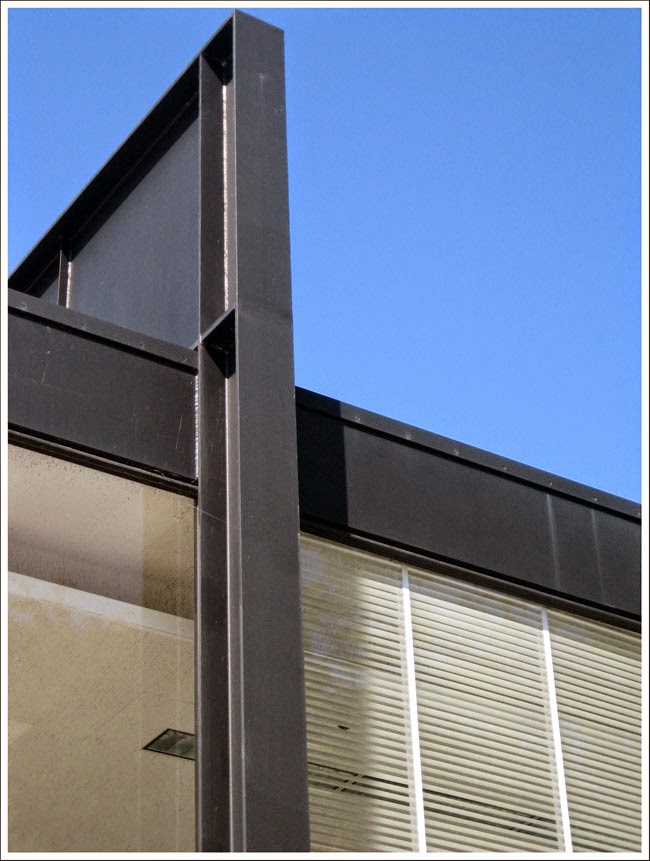S.R. Crown Hall
by: chicago designslinger
[S.R. Crown Hall (1956) Ludwig Mies van der Rohe, Pace Associates, C.F. Murphy & Associates, architects (2005) restoration, Mark Sexton, Krueck & Sexton, architects /Image & Artwork: chicago designslinger]
It's a simple box made of steel and glass. It is a building that has been heralded as one of the top five, if not the number one, epoch defining building of the 20th century. It has been identified as a perfect example of universal space, and as the architect himself put it, Crown Hall was "the cleanest structure we have done, the best to express our philosophy."
[S.R. Crown Hall, Illinois Institute of Technology, 3360 S. State Street, Chicago /Image & Artwork: chicago designslinger]
Mies van der Rohe's philosophy was formed in Germany and brought to the United States when he left his native country and its repressive Nazi mania. He landed in Chicago in 1938 and joined the Armour Institute, an educational institution undergoing a major transformation, to become the head of its architecture program. By the fall of 1956 when Crown Hall held its first classes, the architect had designed nearly 20 buildings for the Illinois Institute of Technology, which was created as the result of a 1940 merger between Armour and the Lewis Institute and its ever expanding campus. Mies headed the architecture department at IIT for 20 years and Crown Hall turned out to be his farewell jesture to the school before retiring in 1958.
[Crown Hall, National Historic Landmark, Chicago /Image & Artwork: chicago designslinger]
In 1940, the newly branded Illinois Institute of Technology began acquiring property around the old Armour building on the city's near south side. The neighborhood at 35th & State Streets was once at the heartbeat of Chicago's African American community, known as Bronzeville. Declared a "derelict slum" by government agencies in the late 1930s, the neighborhood underwent dramatic changes over the next two decades, including the construction of the IIT campus, under Mies' supervision. It took until 1950 for a building to house the architecture department to get underway, and the site chosen was the home of the Mecca Apartments at the northwest corner of 34th and State. The Mecca had been built in 1892 in anticipation of the World's Fair of 1893, and with 195 apartments wrapped around 4-story courtyards, it was the largest apartment building in the city at the time. IIT bought the run-down property in 1942 and proposed tearing down the multi-famliy structure the following year. The people living there, and community organizers, rallied local politicians to save the building, which although terribly neglected, was still providing housing to 1,500 people. Over the next 8 years, as people moved out, the school left the apartments empty, and by 1951 the structure was mostly abandoned and home to a group of squatters.
[Crown Hall, National Register of Historic Places, Chicago /Image & Artwork: chicago designslinger]
Crown Hall would be unlike any other building on the Miesian designed campus. Supported by an exposed exterior steel frame, with large glass panels filling in the wall openings, the interior was a completely free and open space. There was nothing else like it on the planet. The building cost $700,000 to build and the Crown family of Chicago stepped in with a $250,000 donation, so the groundbreaking structure was named in memory of one of the Crown brothers who had died in 1928. Crown Hall's world-wide fame was instantaneous. It predated the completion of one of the architects other notable triumphs, New York's Seagram Building by 8 years, but not everyone loved the place. In an era before air conditioning, the building turned into a terrarium, even in the school term months of September and May, and the flat roof held water and leaked. By the mid-1970s it wasn't unusual to have bits of the water-logged acoustical ceiling tiles come splattering down on student's drafting tables. Then in 2004 the school undertook a much needed $15 million renovation of the building. The redo raised a ruckus however with some Miesian purists when the window stops had to be altered by an 1/8-of-an-inch to allow for the additional thickness of new code-required replacement glass. Because, afterall, less is more.




No comments:
Post a Comment
Note: Only a member of this blog may post a comment.